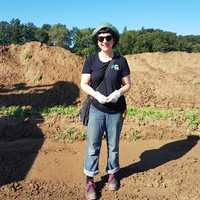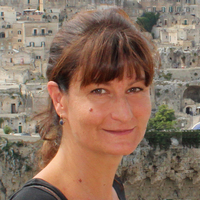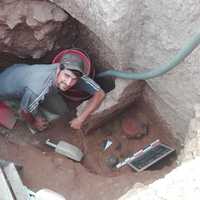Books and Edited Volumes by Melanie Augstein
edited by Robert Schumann, Melanie Augstein, Janine Fries-Knoblach, Steeve Gentner, Margarethe Kirchmayr, Maria Kohle, Holger Wendling. Beiträge zur Ur- und Frühgeschichte Mitteleuropas 107, 2023
Neue Studien zur Sachsenforschung 12 (Wendeburg 2023)
Universitätsforschungen zur Prähistorischen Archäologie 262 (Bonn 2015)
Universitätsforschungen zur Prähistorischen Archäologie 262 (Bonn 2015)

Book title, content & introduction to:
H. Wendling et al. (eds), Measure & Value - Iron Age Syste... more Book title, content & introduction to:
H. Wendling et al. (eds), Measure & Value - Iron Age Systems of Economic and Social Differentiation. BUFM 99 (Langenweissbach, Beier & Beran 2021).
Orders at: www.beier-beran.de
Abstract:
The Iron Age of Central Europe is characterised by a significant intensification of economic relations between the indigenous cultures north of the Alps and the Mediterranean region. The goods and objects, which were incorporated into this complex Iron Age economic system possessed individually measured values for all communication partners involved. Presumably, these values went beyond purely economic categorization. For example, the Hallstatt period "southern import", as well as the Late La Tène consumer and prestige goods played a formative role in the development of Iron Age social systems. As a measure of social differentiation, those material factors were analysed in burial and settlement archaeology. In addition, these studies gave insight into the integration and validity of different categories of objects in the circulation of goods in an economy, which, among other factors, contributed to the development of complex settlement systems and urban structures. Often, however, concrete assessments of the actual but also the intangible value of material culture were limited to general evaluation. These attempted to grasp the value of things in the context of general considerations of their role in an agricultural economy. Ancient written sources, such as Diodorus’ witticism on the exchange of a slave for an amphora of wine, only occasionally offer clues to the quality and merchandise value of goods. Numerous finds of weights but also analyses of vessel capacity indicate regional or supra-regional measures, which apparently contributed to the regulation and standardisation of exchange relations. These culminated in the gradual spread of a monetary system since the Middle La Tène period, which offered an exchange system beyond actual material values on the basis of regulated standards of alloy. Certain finds and features suggest, however, that earlier standardised systems of measurement and value existed, which helped to categorise and correlate economic interaction using measures of capacity, weights, test instruments, and measures of length and time. Whether those measures contributed to the social significance of objects and goods and thus represented a way of estimating the value of things in an ideational dimension, remains a matter of research. The frequent association of measuring devices (gauges, weights etc.) with religious symbols and sacred contexts suggests an indissoluble interweaving of economic values and belief systems not only in numismatics.
Full title: H.Wendling/M. Augstein/J. Fries-Knoblach/S. Gentner/M. Kirchmayr/M. Kohle/K. Ludwig/R... more Full title: H.Wendling/M. Augstein/J. Fries-Knoblach/S. Gentner/M. Kirchmayr/M. Kohle/K. Ludwig/R. Schumann/J. Wiethold (eds), Objekt • Depot • Motiv. Kontext und Deutung von Objektniederlegungen im eisenzeitlichen Mitteleuropa. Beiträge zur Jahressitzung der AG Eisenzeit bei der gemeinsamen Tagung des WSVA sowie des MOVA vom 19.–22. März 2018 in Halle/Saale. Beiträge zur Ur- und Frühgeschichte Mitteleuropas 95 (Langenweißbach 2020).
Full title: P. Trebsche/H. Wendling/M. Augstein/J. Fries-Knoblach/K. Ludwig/R. Schumann/C. Tapper... more Full title: P. Trebsche/H. Wendling/M. Augstein/J. Fries-Knoblach/K. Ludwig/R. Schumann/C. Tappert/J. Wiethold (eds), LANDwirtschaft | LANDnutzung. Aspekte der Aneignung und Ökonomie ländlicher Ressourcen im eisenzeitlichen Mitteleuropa. Beiträge zur Jahressitzung der AG Eisenzeit bei der Tagung des Nordwestdeutschen Verbandes für Altertumsforschung vom 18.–21. September 2016 in Münster/Westfalen. Beiträge zur Ur- und Frühgeschichte Mitteleuropas 93 (Langenweißbach 2020). - Order at www.beier-beran.de
Title and content - full title: H. Wendling/M. Augstein/J. Fries-Knoblach/K. Ludwig/R. Schumann/... more Title and content - full title: H. Wendling/M. Augstein/J. Fries-Knoblach/K. Ludwig/R. Schumann/C. Tappert/P. Trebsche/J. Wiethold (eds.), Übergangswelten – Todesriten. Neue Forschungen zur Bestattungskultur der europäischen Eisenzeit. Beiträge zur internationalen Tagung der AG Eisenzeit in Hallein 2015 und zur Sitzung der AG Eisenzeit während des 8. Deutschen Archäologiekongresses in Berlin 2014. Beiträge zur Ur- und Frühgeschichte Mitteleuropas 86 (Langenweißbach 2018).

Manfred K. H. Eggert hat sich wie kaum ein anderer deutscher Prähistoriker mit methodologischen u... more Manfred K. H. Eggert hat sich wie kaum ein anderer deutscher Prähistoriker mit methodologischen und theoretischen Aspekten der Ur- und Frühgeschichtswissenschaft beschäftigt. Die in diesem Band versammelten Aufsätze aus vier Jahrzehnten sind als grundlegender und programmatischer Beitrag zu einer kulturanthropologisch ausgerichteten Archäologie zu verstehen. Sie entfalten ein vielseitiges Bild von Eggerts wissenschaftlicher Arbeit – von kritischen Stellungnahmen zur sogenannten ›Fürstensitz‹-Problematik der Frühen Eisenzeit Mitteleuropas über Beiträge zum Potential der Ethnoarchäologie und zur Notwendigkeit von Analogien in der Archäologie bis hin zu erkenntnistheoretischen Fragen und reflexiven Überlegungen zum Selbstverständnis der Prähistorischen Archäologie. Die dabei dezidiert verfolgte kulturwissenschaftliche Perspektive zu verschiedenen Forschungsfeldern der Prähistorischen Archäologie ist in dieser Textsammlung allgegenwärtig und eine Charakteristik seines Schaffens.
Papers by Melanie Augstein
In: C. Giostra – E. Aspöck – D. Winger (Hrsg.), Fuerto e ritualità? Riaprire le sepolture nell’al... more In: C. Giostra – E. Aspöck – D. Winger (Hrsg.), Fuerto e ritualità? Riaprire le sepolture nell’alto medioevo. VI Incontro Internazionale per l’Archeologia barbarica Milano, Università Cattolica (da remoto), 9 dicembre 2022. Archeologia Barbarica 7 (Mantova 2024) 181–195.
In: H.-J. Karlsen – M. Augstein, Das Gräberfeld von Nienbüttel – der »reichste Urnenfriedhof des ... more In: H.-J. Karlsen – M. Augstein, Das Gräberfeld von Nienbüttel – der »reichste Urnenfriedhof des östlichen Hannovers«. Die Altgrabungen von 1901 bis 1911. Neue Studien zur Sachsenforschung 12 (Wendeburg 2023) 65–82.
In: O. Grimm (Hrsg.) in Zusammenarbeit mit D. Groß – A. Pesch – O. Sundqvist – A. Zedrosser, Bear... more In: O. Grimm (Hrsg.) in Zusammenarbeit mit D. Groß – A. Pesch – O. Sundqvist – A. Zedrosser, Bear and Human – Facets of a Multi-layered Relationship from Past to Recent Times with an Emphasis on Northern Europe. The Archaeology of Northern Europe 3 (Turnhout 2023) 1065–1089.
In: B. Ludowici und H. Pöppelmann (Hrsg.), New Narratives for the First Millennium? Alte und neue... more In: B. Ludowici und H. Pöppelmann (Hrsg.), New Narratives for the First Millennium? Alte und neue Perspektiven der archäologischen Forschung zum 1. Jahrtausend. Neue Studien zur Sachsenforschung 11 (Wendeburg 2022) 227–244.
In: Holger Wendling et al. (Hrsg.), Objekt • Depot • Motiv. Kontext und Deutung von Objektniederl... more In: Holger Wendling et al. (Hrsg.), Objekt • Depot • Motiv. Kontext und Deutung von Objektniederlegungen im eisenzeitlichen Mitteleuropa. Beiträge zur Ur- und Frühgeschichte Mitteleuropas 95 (Langenweißbach 2020) 51–62.
Beiträge zur Archäologie in der Oberpfalz und in Regensburg 13. Büchenbach: Dr. Faustus 2020, 109... more Beiträge zur Archäologie in der Oberpfalz und in Regensburg 13. Büchenbach: Dr. Faustus 2020, 109–208.
Siedlungsforschung. Archäologie – Geschichte – Geographie 39, 2021, 307–321.
In: R. Karl & J. Leskovar (Hrsg.), Interpretierte Eisenzeiten. Fallstudien, Methoden, Theorie. Ta... more In: R. Karl & J. Leskovar (Hrsg.), Interpretierte Eisenzeiten. Fallstudien, Methoden, Theorie. Tagungsbeiträge der 8. Linzer Gespräche zur interpretativen Eisenzeitarchäologie. Studien zur Kulturgeschichte von Oberösterreich, Folge 49 (Linz 2019) 17–26.
In: M. Augstein & M. Hardt (Hrsg.), Sächsische Leute und Länder – Benennung und Lokalisierung von Gruppenidentitäten im ersten Jahrtausend. Neue Studien zur Sachsenforschung 10 (Braunschweig 2019) 9–21.











Uploads
Books and Edited Volumes by Melanie Augstein
H. Wendling et al. (eds), Measure & Value - Iron Age Systems of Economic and Social Differentiation. BUFM 99 (Langenweissbach, Beier & Beran 2021).
Orders at: www.beier-beran.de
Abstract:
The Iron Age of Central Europe is characterised by a significant intensification of economic relations between the indigenous cultures north of the Alps and the Mediterranean region. The goods and objects, which were incorporated into this complex Iron Age economic system possessed individually measured values for all communication partners involved. Presumably, these values went beyond purely economic categorization. For example, the Hallstatt period "southern import", as well as the Late La Tène consumer and prestige goods played a formative role in the development of Iron Age social systems. As a measure of social differentiation, those material factors were analysed in burial and settlement archaeology. In addition, these studies gave insight into the integration and validity of different categories of objects in the circulation of goods in an economy, which, among other factors, contributed to the development of complex settlement systems and urban structures. Often, however, concrete assessments of the actual but also the intangible value of material culture were limited to general evaluation. These attempted to grasp the value of things in the context of general considerations of their role in an agricultural economy. Ancient written sources, such as Diodorus’ witticism on the exchange of a slave for an amphora of wine, only occasionally offer clues to the quality and merchandise value of goods. Numerous finds of weights but also analyses of vessel capacity indicate regional or supra-regional measures, which apparently contributed to the regulation and standardisation of exchange relations. These culminated in the gradual spread of a monetary system since the Middle La Tène period, which offered an exchange system beyond actual material values on the basis of regulated standards of alloy. Certain finds and features suggest, however, that earlier standardised systems of measurement and value existed, which helped to categorise and correlate economic interaction using measures of capacity, weights, test instruments, and measures of length and time. Whether those measures contributed to the social significance of objects and goods and thus represented a way of estimating the value of things in an ideational dimension, remains a matter of research. The frequent association of measuring devices (gauges, weights etc.) with religious symbols and sacred contexts suggests an indissoluble interweaving of economic values and belief systems not only in numismatics.
Papers by Melanie Augstein
H. Wendling et al. (eds), Measure & Value - Iron Age Systems of Economic and Social Differentiation. BUFM 99 (Langenweissbach, Beier & Beran 2021).
Orders at: www.beier-beran.de
Abstract:
The Iron Age of Central Europe is characterised by a significant intensification of economic relations between the indigenous cultures north of the Alps and the Mediterranean region. The goods and objects, which were incorporated into this complex Iron Age economic system possessed individually measured values for all communication partners involved. Presumably, these values went beyond purely economic categorization. For example, the Hallstatt period "southern import", as well as the Late La Tène consumer and prestige goods played a formative role in the development of Iron Age social systems. As a measure of social differentiation, those material factors were analysed in burial and settlement archaeology. In addition, these studies gave insight into the integration and validity of different categories of objects in the circulation of goods in an economy, which, among other factors, contributed to the development of complex settlement systems and urban structures. Often, however, concrete assessments of the actual but also the intangible value of material culture were limited to general evaluation. These attempted to grasp the value of things in the context of general considerations of their role in an agricultural economy. Ancient written sources, such as Diodorus’ witticism on the exchange of a slave for an amphora of wine, only occasionally offer clues to the quality and merchandise value of goods. Numerous finds of weights but also analyses of vessel capacity indicate regional or supra-regional measures, which apparently contributed to the regulation and standardisation of exchange relations. These culminated in the gradual spread of a monetary system since the Middle La Tène period, which offered an exchange system beyond actual material values on the basis of regulated standards of alloy. Certain finds and features suggest, however, that earlier standardised systems of measurement and value existed, which helped to categorise and correlate economic interaction using measures of capacity, weights, test instruments, and measures of length and time. Whether those measures contributed to the social significance of objects and goods and thus represented a way of estimating the value of things in an ideational dimension, remains a matter of research. The frequent association of measuring devices (gauges, weights etc.) with religious symbols and sacred contexts suggests an indissoluble interweaving of economic values and belief systems not only in numismatics.
Der gesamte Band online unter:
https://journals.ub.uni-heidelberg.de/index.php/arch-inf/issue/view/5592
AG Römische Kaiserzeit im Barbaricum, 84. Verbandstagung des Nordwestdeutschen Verbands für Altertumsforschung in Bochum
– Eine Veranstaltung der Stadt-und Kreisarchäologie Uelzen.
Online login details: https://cloud.landesmuseen.sh/apps/bbb/b/iHZarycPqnGke65y
Programm:
https://www.grk-konzepte-mensch-natur.uni-mainz.de/workshop-programm-koerper-und-gesellschaft/
AG »Theorien in der Archäologie (TidA e.V.)«
22. und 23.09.2020
Thema: Außenseiter*innen, Randgruppen und andere Unsichtbare
7. Linzer Gespräche zur interpretativen Eisenzeitarchäologie, 17.–19. November 2016
6. Linzer Gespräche zur interpretativen Eisenzeitarchäologie, 27.–29. November 2014
DThe zoom link will be announced in the week before the conference via the mailing list of the AG Eisenzeit. You can also obtain the access data via sprecher@ag-eisenzeit.de
Cremation is gaining popularity in present-day Europe, while inhumation is rejected for primarily economic and practical reasons, i.e. cremations being a more affordable option and for lack of burial plots in the larger cities. The reasons for choosing between cremation and inhumations were however not as simplistic in the past, a cremation pyre will for example require knowledge and large amounts of wood and might not have been neither easier nor economically more affordable. Recent archaeological studies have shown that the ‘simple’ cremation graves hold valuable information about intricate mortuary processes and practices (e.g. body treatments) surrounding the funerals, which opens the space for further questions and interpretations regarding social, cultural or religious aspects (e.g. body concepts, symbolic communication, change of religious beliefs and taboos in death rituals). Interdisciplinary studies have revealed detailed insight into burning conditions on the pyre as well as absolute dating and mobility analyses of the cremated bone.
We invite papers from a broad range of disciplines working with cremation practices and burials in the past and today, including archaeological case studies of cremation cemeteries, burial rites and burial goods. We especially welcome paper investigating historical and ethnographic sources, religious and social studies, anthropological studies of human and animal remains, and applications of scientific methods on cremation remains, e.g. strontium, carbon and oxygen isotope analysis and radiocarbon dating.
WSVA in Jena vom 04.-07. Oktober 2021
Schmuck, Trachtbestandteile und Überreste von Kleidung haben seit Beginn der professionellen
Forschung einen festen Platz in der Eisenzeitarchäologie. Der Fokus lag lange insbesondere auf den
metallenen Trachtbestandteilen und Schmuckobjekten, zu denen in den letzten Jahrzehnten auch
verstärkt Studien zu Textilfunden traten. Die Bedeutung entsprechender Hinterlassenschaften in der
Eisenzeitarchäologie erklärt sich durch ihr mannigfaltiges Aussagepotenzial. Als Teil sich schnell
wandelnder Moden sind beispielsweise Fibeln, Nadeln und Ringschmuck chronologisch sensibel sowie
oftmals in geschlossenen Funden wie Gräbern anzutreffen und damit für typologische und
feinchronologische Untersuchungen prädestiniert. Wenngleich sich der Fokus in jüngerer Zeit von
typochronologischen Studien hin zu weiterführenden Fragestellungen verschoben hat, haben diese
Funde nichts an ihrer Relevanz für die Eisenzeitarchäologie verloren. So sind Fragen zu Modi der
nonverbalen Kommunikation durch Tracht und Schmuck, zu sozialer Differenzierung, Gender und
anderen Identitäten – und damit nach der generellen Tragfähigkeit des „Trachtbegriffs“ und eines
„Trachtkonzepts“ – maßgeblich. Ebenso werden entsprechende Objekte häufig zur Abgrenzung
regionaler Gruppen herangezogen und, sofern sie außerhalb ihres Hauptverbreitungsgebietes
auftreten, als Hinweise auf Mobilität und Fernbeziehungen diskutiert. Zudem ermöglichen metallene
und textile Funde zahlreiche Einblicke in das (Kunst)Handwerk der Eisenzeit oder
Gebrauchsspurenanalysen geben Aufschluss zu Trageweisen. Diese hier angerissenen
Themenkomplexe lassen sich um zahlreiche weitere Fragestellungen erweitern, die die Relevanz dieser
Fundgruppen klar aufzeigen.
Over the past few years, prehistoric archaeology has seen an intensified debate on commemoration. Numerous studies throughout the discipline explore the perception and construction of the past, cultures of memory and references to former times. This trend in prehistoric archaeology reflects a more general debate concerning memory cultures in the humanities and in cultural studies. Memory sites, cultural and collective memories and other aspects have been widely discussed in the past few
decades and have found their way into prehistoric archaeology. Commemoration is here not understood as reminiscence of a factual past, but rather as a product of contemporary processes of negotiation, manipulation, control and active maintenance. Thus, memory cultures allow for thecomposition of different narratives. Beyond this narrower scope, this field links to many broader topicsand research questions of prehistoric archaeology, such as the formation of identities, perception of time, legitimation of power and claims to power, appropriation of land, ancestor veneration, kinship and ancestry and so on. In our session we will explore the topic of memory cultures specifically for the Central European Iron Ages and discuss and analyse how the more recent and the more remote past were perceived and remembered in different times and regions. Perceptions of the past that hint at memory cultures are attested in the archaeological record in numerous ways, for instance in the reuse of burial sites and other monuments, the reappearance of old customs, the perception of cultural landscape, the handling of old material culture and so on. There is hence a vast corpus of evidence for
the Iron Ages which allows the exploration of this topic in all its different facets.